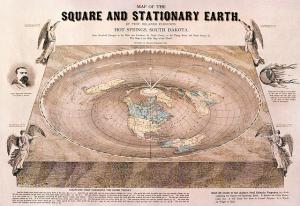Richard Carrier (born in 1969), a former Protestant atheist, is, according to Wikipedia, “an American historian, author, and activist, whose work focuses on empiricism, atheism, and the historicity of Jesus [he’s a “mythicist”]. A long-time contributor to self-published skeptical web sites, including The Secular Web and Freethought Blogs, Carrier has published a number of books and articles on philosophy and religion in classical antiquity, discussing the development of early Christianity from a skeptical viewpoint, and concerning religion and morality in the modern world. He has publicly debated a number of scholars on the historical basis of the Bible and Christianity. . . . In 2008, Carrier received a doctorate in ancient history from Columbia University, where he studied the history of science in antiquity.”
*****
I’m responding to a portion of Carrier’s article, “Science Then: The Bible vs. The Greeks Edition” (11-30-15). His words will be in blue.
Isaiah 40:22 (RSV) It is he who sits above the circle of the earth, . . .
I also highly recommend Ed Babinski’s excellent article “The Cosmology of the Bible,” in The Christian Delusion, which puts the Bible’s “science” in the context of its surrounding cultures, finding it pretty much is just copying them, often badly, and getting things just as wrong in result. . . .
Isaiah 40:22 does not say the earth is a sphere. It says it is a circle. Which is flat. The word for circle is chuwg (Job 22:14 and 26:10; Proverbs 8:27). The word for sphere is duwr (Isaiah 22:18). The latter can also mean circle. But the former never means sphere. It refers to walking around a thing (a two-dimensional activity). The word for ball, instead, derives from heaping things up, from huts to garbage piles (a three-dimensional activity). Even Greek translations by ancient Rabbinical experts used gyron, “circle,” rather than sphaira, “sphere,” so even they understood this to mean circle and not sphere. So, in fact, Isaiah 40:22 says the earth is a flat disk. Like every other culture thought at the time. Babinski’s chapter cited above goes into more detail comparing the ancient Hebrew cosmology of the structure of earth and heavens throughout the Bible, well establishing it was the same primitive model adopted by everyone else of the time, not some fancy new scientific one.
First of all, Ed Babinski has a BA degree in biology, according to his academia.edu page, and “35 years working in libraries, public and university”: work that has earned him the accolade of being a “living legend.” Elsewhere, I saw it claimed (by someone who was debating him) that he has a Master’s degree in creative writing, but I couldn’t confirm it. That’s all well and good, but (even with the Master’s) it doesn’t exactly qualify him as some expert in biblical Hebrew and literature.
Much more qualified to explain the meaning of Isaiah 40:22 would be someone like Dr. Justin Rogers, who serves as an Associate Professor of Biblical Studies at Freed-Hardeman University. He holds an M.A. in New Testament from FHU as well as an M.Phil. and Ph.D. in Hebraic, Judaic, and Cognate Studies from Hebrew Union College-Jewish Institute of Religion. His superb and extremely helpful article, “Does the Bible Teach a Flat Earth?” (2017) elaborates upon this topic in wonderful detail:
One notices instantly that almost every passage cited in favor of the flat-Earth position occurs in a poetic context. To be responsible readers of the Bible, we must respect the genre of literature we are reading. Poetry is to be read differently than prose; it is more expressive, emotional, and metaphorical. . . . a common-sense understanding of how poetry functions prevents us from making erroneous interpretive deductions. To insist that metaphorical language must be interpreted literally is to contradict the original authorial intent. . . .
[W]e cannot locate a single verse in the Bible that teaches the Earth is flat. Neither in prose nor in poetry, neither by means of phenomenological language nor metaphor, do we find Scripture communicating a flat Earth. The flat-Earth theory is an interpretive deduction, usually based on poetic hyperbole. But is a flat Earth even an accurate interpretive deduction? As we will see, it is far from obvious that the Bible teaches the Earth is flat. . . .
[S]uch a literal reading [of Isaiah 40:22] ignores the poetic context and the obvious anthropomorphism. . . . the ancient Greek translation renders the term γῦρος (gūros), or “ring.” Further, the term “on” (על, ‘al) can also be translated “above,” without implying contact with an object (e.g., NASB, ESV). So this passage does not necessarily communicate a spherical Earth, but neither does it imply a flat Earth. . . .
Again, these passages occur in poetic contexts, and it can be dangerous to impose a literal meaning on figurative language, as we have discussed. Unlike God, Job’s friends [Job 22:14; 26:10; 37:18] did not necessarily have a perfect scientific understanding, and are, in any case, speaking hyperbolically in Hebrew poetry. Their words simply reflect a popular expression of God’s complete sovereignty over nature. Nevertheless, one thing is sure: there is no thought of a flat Earth anywhere. The “circle of the earth” is a metaphor to be sure, but not even metaphorically is it understood as flat.
It should be noted that the Hebrew Bible does not have an equivalent for the term “sphere,” which in modern Hebrew is the loanword ספירה (sefîrāh). The word “ball” (דור, dūr) occurs in English translations in Isaiah 22:18, but it is clear from Isaiah 29:3 (the only other place the noun occurs) that it refers to a “roll” of items that have encircled a central object. A related verb form is found one other time in the Bible to describe stacked and perhaps “bound” wood (Ezekiel 24:5). In other words, the shape of such an object is beyond the scope of the term. So, the authors of the Hebrew Bible simply lacked the vocabulary to describe a perfectly round object. We cannot expect them to say what they did not have the words to communicate. [bolding in original]
It’s necessary to give a brief overview of the proper understanding of biblical cosmology (which Carrier and seemingly most atheists clearly don’t grasp). To do so, I shall cite a classic work on the subject, The Christian View of Science and Scripture, by the Baptist Bernard Ramm (Grand Rapids, Michigan: Eerdmans, 1954, 96-102). In his section on “Biblical Cosmology” he offers a very helpful overview of many significant presupposition-level considerations (italics his own throughout):
[T]he references of the writers of the Bible to natural things are popular, non-postulational, and in terms of the culture in which the writers wrote. This principle applies directly to Biblical cosmology. . . . Biblical cosmology is in the language of antiquity and not of modern science, nor is it filled with anticipations which the future microscope and telescope will reveal. We do not agree with over-zealous Fundamentalists who try to find Einsteinian and modern astrophysical concepts buried in Hebrew words and expressions. We also disagree with the religious liberals who object to Biblical cosmology because it is not scientific.
. . . The cosmology of the Bible is not systematized and is not postulational. It is neither for nor against any of the current and ancient theories of the universe except where they might be polytheistic or in conflict with basic Christian metaphysics. But the Bible does not support Aristotle or Ptolemy or Copernicus or Descartes or Newton or Einstein or Milne . . . it gives us no positive cosmology.
We must consider the efforts of radical critics to impose a cosmology on the Bible as an artificial, stilted, and abortive effort. . . .
Gaenssle, a Semitic scholar, takes the radical critics to task likewise for imposing on the Bible a stilted, artificial cosmology that is nowhere clearly and systematically taught in Scripture [“A Look at Current Biblical Cosmologies,” Concordia Theological Monthly, 23:738-749]. He singles out two basic ideas of this reconstruction of the radical critics to show that their contentions are baseless. . . .
It is improper to construct a so-called modern or scientific cosmology from the Biblical evidence; and it is also improper to try to model one after Babylonian concepts. In that there is no systematic exposition of a cosmology in the Bible, and in that the Bible abounds with either popular expressions or poetic expressions, it is not capable of a systematic construction with reference to a cosmology. The best we can do is to (i) indicate the freedom of the Bible from mythological polytheistic or grotesque cosmologies; (ii) note the general hostility of the Bible to cosmologies which are antitheistic; and (iii) clearly present the theocentric view of the Bible towards Nature.
It is typical of radical critics to play up the similarity of anything Biblical with the Babylonian, and to omit the profound differences or gloss over them. When the Biblical account is set side by side with any other cosmology its purity, its chasteness, its uniqueness, its theocentricity are immediately apparent.
Earlier in his book (pp. 66-67, 69-70), Ramm made an even more basic summary of biblical language in relation to science:
A. The language of the Bible with reference to natural matters is popular, not scientific. . . .
B. The language of the Bible is phenomenal. By phenomenal we mean “pertaining to appearances.” . . .
C. . . . the language of the Bible is non-postulational with reference to natural things. By this we mean that the Bible does not theorize as to the actual nature of things . . . . there is no theory of matter in the Bible. . . .
D. The language of the Bible employs the culture of the times in which it was written as the medium of revelation.
I think Carrier (even allowing for his obvious ignorance on this particular topic) needs to cut the Prophet Isaiah and the Bible a lot of slack (to put it mildly and as charitably as I can). The prophet Isaiah lived c. 740 to c. 681 BC, per the Jewish Virtual Library. And of course, critical scholarship posits two or three “Isaiahs”: with parts of chapters 1-39 of the book supposedly written during the time of King Josiah (r. c. 640-609 BC), and a third “Isaiah” who wrote around 539 BC: the time of the return of the Jews to Israel, from their exile in Babylon.
By contrast, Wikipedia (“Spherical Earth”) tells us that “The earliest documented mention of the concept dates from around the 5th century BC [i.e., 499-400 BC], when it appears in the writings of Greek philosophers.” So the Greeks didn’t know any more than Isaiah (+ #2 / + #3?) — even the latest supposed one — knew, and didn’t yet have any concept of a spherical earth. According to an academic page, “Background to Cosmology: The Ancient Greeks”:
The earliest views, going back to the time of Homer and Hesiod (the 8th century BC) postulated a flat or cylindrical earth located in a hemispherical cosmos that surrounded or enveloped it.
This page traces the advent of sphericity among the Greeks a bit earlier than Wikipedia did, to Pythagoras (app. 560-480BC). Wikipedia (“Flat Earth”) notes many famous and renowned Greek thinkers who held that the earth’s shape was something other than a sphere:
Philosophers
Several pre-Socratic philosophers believed that the world was flat: Thales (c. 550 BC) according to several sources, and Leucippus (c. 440 BC) and Democritus (c. 460–370 BC) according to Aristotle.*Thales thought that the Earth floated in water like a log. It has been argued, however, that Thales actually believed in a round Earth. Anaximander (c. 550 BC) believed that the Earth was a short cylinder with a flat, circular top that remained stable because it was the same distance from all things. Anaximenes of Miletus [c. 586-c. 526 BC] believed that “the Earth is flat and rides on air; in the same way the Sun and the Moon and the other heavenly bodies, which are all fiery, ride the air because of their flatness”. Xenophanes of Colophon (c. 500 BC) thought that the Earth was flat, with its upper side touching the air, and the lower side extending without limit.
Belief in a flat Earth continued into the 5th century BC. Anaxagoras (c. 450 BC) agreed that the Earth was flat, and his pupil Archelaus [fl. 5th c. BC] believed that the flat Earth was depressed in the middle like a saucer, to allow for the fact that the Sun does not rise and set at the same time for everyone.
Historians
Hecataeus of Miletus [c. 550 BC-c. 476 BC] believed that the Earth was flat and surrounded by water. Herodotus [c. 484-c. 425 BC] in his Histories ridiculed the belief that water encircled the world, yet most classicists agree that he still believed Earth was flat because of his descriptions of literal “ends” or “edges” of the Earth. [footnotes removed]
Other ancient cultures were just as ignorant about cosmology, according to Wikipedia:
In ancient China, the prevailing belief was that the Earth was flat and square, while the heavens were round, an assumption virtually unquestioned until the introduction of European astronomy in the 17th century. The English sinologist Cullen emphasizes the point that there was no concept of a round Earth in ancient Chinese astronomy: . . .
Why, then, give poor ol’ Isaiah (Isaiahs?) hell and distort even what he [#3?] stated (in c. 539 BC, according to skeptical dating, or in the 8th-7th century according to Christian and Jewish tradition), while ignoring the utter ignorance of the Greeks at the same time?
Well, it’s because the latter doesn’t fit into the anti-biblical / anti-Christian / pro-Greek agenda, you see! If my analysis (from qualified scholars, not librarians) is correct, Isaiah and the Bible were agnostic on the subject, and don’t present an actual identifiable cosmology; whereas the ancient Greeks at the same time mostly believed in a flat earth or an earth of some other shape besides spherical.
Where are all the articles from atheists (consistently) mocking and insulting them as anti-scientific ignoramuses and intellectual troglodytes? I don’t insult any of these ancient thinkers. I recognize (unlike, apparently, a great many atheists) that accurate astronomy and geodesy (like all fields of knowledge) developed and evolved, and it took time. It does no one any good to despise and misrepresent thinkers (or anyone, like, for example, a biblical prophet), simply because they lived a long time ago and/or don’t happen to fit into our own worldview category.
***
Practical Matters: Perhaps some of my 4,000+ free online articles (the most comprehensive “one-stop” Catholic apologetics site) or fifty books have helped you (by God’s grace) to decide to become Catholic or to return to the Church, or better understand some doctrines and why we believe them.
Or you may believe my work is worthy to support for the purpose of apologetics and evangelism in general. If so, please seriously consider a much-needed financial contribution. I’m always in need of more funds: especially monthly support. “The laborer is worthy of his wages” (1 Tim 5:18, NKJV). 1 December 2021 was my 20th anniversary as a full-time Catholic apologist, and February 2022 marked the 25th anniversary of my blog.
PayPal donations are the easiest: just send to my email address: [email protected]. You’ll see the term “Catholic Used Book Service”, which is my old side-business. To learn about the different methods of contributing, including 100% tax deduction, etc., see my page: About Catholic Apologist Dave Armstrong / Donation Information. Thanks a million from the bottom of my heart!
***
Photo credit: A “flat-Earth” map drawn by Orlando Ferguson in 1893 [public domain / Wikimedia Commons]
***
Summary: Atheist anti-theist Richard carrier claims that the Bible teaches a flat earth, based on Isaiah 40:22. Qualified scholars say the Bible teaches no particular cosmology.














